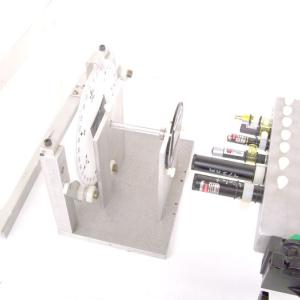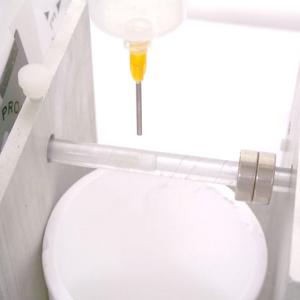College of Liberal Arts & Sciences
6H30.80 - Faraday Rotation
Our procedure is to shine the desired laser through the sample without the magnetic field being applied, set the analyzer to zero degrees, and rotate the polarizer until minimum light transmission or extinction is achieved on the screen. The magnetic field is then applied by moving the ring magnets over the sample at which point a bright spot of light will appear on the screen. Rotating the analyzer until that bright spot is again at a minimum or extinguished will give you the rotation angle for that wavelength.
- Giuseppe Colicchia, "A Simple Device for Exploring Optical Activity", TPT, Vol. 42, Nov. 2004, p. 748.
- Jain, Kumar, Zhou, Li, Tripathy, "A Simple Experiment for Determining Verdet Constants Using Alternating Current Magnetic Fields", AJP, Vol. 67, # 8, Aug. 1999, p. 714.
- Eliot M. Briggs and Richard W. Peterson, "Liquid Cell Faraday Modulator", AJP, Vol. 61, #2, Feb. 1993, p. 186.
- Frank L. Pedrotti, Peter Bandettini, "Faraday Rotation in the Undergraduate Advanced Laboratory", AJP, Vol. 58, # 6, June 1990, p. 542.
- Frank J. Loeffler, "A Faraday Rotation Experiment for the Undergraduate Physics Laboratory", AJP, Vol. 51, #7, July 1983, p. 661.
- Kam L. Yan, W. P. Lonc, S. J., "MIcrowave Faraday Rotation", AJP, Vol. 43, #8, Aug. 1975, p. 718.
- Wallace A. Hilton, "P-5", Experiments in Optical Physics, p. 73.
- Michael E. Flatte, Dale Stille, "Faraday Rotation as a Lecture Demonstration".
- The Relaxation Times, "'Kaizen' on Faraday Rotation", Newsletter of Teachspin Inc., Oct. 2018.
Disclaimer: These demonstrations are provided only for illustrative use by persons affiliated with The University of Iowa and only under the direction of a trained instructor or physicist. The University of Iowa is not responsible for demonstrations performed by those using their own equipment or who choose to use this reference material for their own purpose. The demonstrations included here are within the public domain and can be found in materials contained in libraries, bookstores, and through electronic sources. Performing all or any portion of any of these demonstrations, with or without revisions not depicted here entails inherent risks. These risks include, without limitation, bodily injury (and possibly death), including risks to health that may be temporary or permanent and that may exacerbate a pre-existing medical condition; and property loss or damage. Anyone performing any part of these demonstrations, even with revisions, knowingly and voluntarily assumes all risks associated with them.

